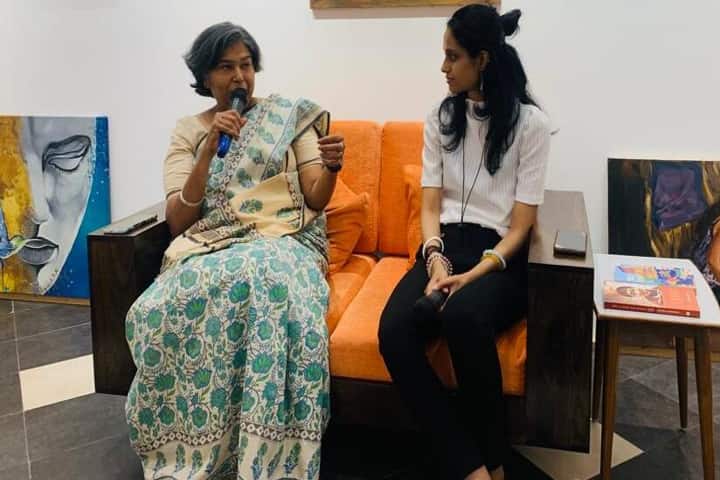
The two authors, Madhulika Liddle and Aashisha Chakraborty in conversation at 1000 Words Art Gallery
Book lovers of Delhi were treated to an enthralling conversation over the weekend on historical fiction. The event jointly organised by 1000 Words Art Gallery and Aesthetes and Savants, saw a lively discussion between two noted authors of historical fiction genre — Madhulika Liddle, the first Indian author to win the prestigious Commonwealth Broadcasting Association’s Short Story Competition and Aashisha Chakraborty, the winner of PM YUVA fellowship.
Emphasising on the need for the narrative of a historical book to reflect contemporary political correctness, Liddle referred to her writings. The author whose best-known series of works are historical whodunnits featuring a 17th Century Mughal detective Muzaffar Jang. The Mughal nobleman is a detective who loves solving tricky and difficult crimes in the Delhi of Shahjahan era.
Stating that she moulded Jang as a feminist and someone who saw all people as equal, Liddle remarked: “If I gave you a hero who was that discriminatory and as chauvinistic as your average Mughal nobleman would be, would you want to read him now?”
The author of eight novels, majority of which are set in Delhi, pointed out that historical fiction requires immense research on the part of the writer. The research many times proves to be an eyeopener for the author too. Citing an example, she said though a resident of Delhi for four decades, she discovered how Pandara Road got its name. “Not many are aware that Pandara Road was actually named Pandava Road but some clerk, who probably had a case of bad handwriting, wrote the name in such a manner that it was misinterpreted as Pandara Road and by the time someone actually pointed out the error, the name stuck.”
Agreeing with Madhulika on the importance of meticulous research, Aashisha said that it is imperative to get the setting for the narrative right and for this reading research papers and historical accounts is must. Making an interesting observation, she added: “Only 20% of the research comes into the book after one has finished the draft.”
Aashisha’s second novel “The 13-year-old Queen and Her Inherited Destiny” is a historical fiction inspired by the life of a relatively unknown woman freedom fighter from Nagaland, Gaidinliu Pamei. She is popularly called Rani Gaidinliu, after India’s first Prime Minister, Jawaharlal Nehru bestowed her with the honour of Rani.
Revealing on how she decided to write on Rani Gaidinliu, Aashisha said on winning the PM YUVA fellowship she was asked to write about unsung freedom fighters. “I agreed, because we have a lot of writings on the Bhagat Singhs and the (Chandrashekhar) Azads of the world and I thought, there must be some people who have made changes and then I thought about women leaders.”
She went on to add: “That’s when I realised that most of the historical narrative was centred around the known names like Sarojini Naidu and Kamala Nehru. Since I come from the east, I decided to focus my research on that region and was fascinated by the story of Rani Gaidinliu, who spent 14 years in prison for India’s freedom.”
Following the conversation between the authors the floor was thrown open to the large gathering. This session was very interactive as well as insightful.
The audience also got a chance to take the centre-stage as several of them read out their poetry and compositions, which was much appreciated by the authors.
Tejeesh Nippun Singh who owns 1000 Words Art Gallery promised the audience many more such lively interactions. “This is the first in the series of literary interactions and we will be bringing more authors and artists to share their thoughts. The gallery will also organise cultural meets that bring together the performing and visual arts.”














